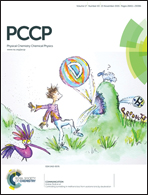Direct observation of epitaxial organic film growth: temperature-dependent growth mechanisms and metastability†
Abstract
The growth of the first ten layers of organic thin films on a smooth metallic substrate has been investigated in real-time using the model system PTCDA on Ag(111). The complex behaviour is comprehensively studied by electron microscopy, spectroscopy and diffraction in a combined PEEM/LEEM instrument revealing several new phenomena and yielding a consistent picture of this layer growth. PTCDA grows above room temperature in a Stranski–Krastanov mode, forming three-dimensional islands on a stable bi-layer, in competition with metastable 3rd and 4th layers. Around room temperature this growth mode changes into a quasi layer-by-layer growth, while at temperatures below about 250 K a Vollmer–Weber-like behaviour is observed. By means of laterally resolved soft X-ray absorption spectroscopy the orientation of all adsorbed molecules is found to be homogeneously flat lying on the surface, even during the growth process. The films grow epitaxially, showing long-range order with rotational domains. For the monolayer these domains could be directly analysed, showing an average size of several micrometers extending over substrate steps.


 Please wait while we load your content...
Please wait while we load your content...